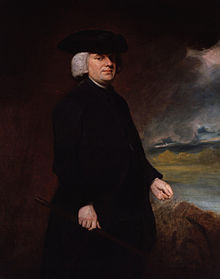William Paley
| William Paley | |
|---|---|
 William Paley (1743–1805) | |
| Lahir | Juli 1743 Peterborough, Inggris |
| Meninggal | 25 Mei 1805 Bishopwearmouth, Inggris |
| Tempat tinggal | Inggris |
| Kebangsaan | Inggris |
| Almamater | Christ's College, Cambridge |
| Dikenal atas | Berkontribusi pada filsafat moral, filsafat politik, etik dan filsafat agama |
| Penghargaan | Members' Prize, Cambridge, 1765 |
| Karier ilmiah | |
| Bidang | teologi alam |
| Institusi | Giggleswick Grammar School, Christ's College, Cambridge, Giggleswick Parish, Katedral Carlisle, Katedral Lincoln, Katedral Durham |
William Paley (1743– 1805 M) adalah seorang filsuf di dunia Barat yang mendukung argumen teleologis.[1] Ia merupakan seorang rohaniwan, apolog Kristen, filsuf, dan utilitarianisme berkebangsaan Inggris. Ia paling dikenal karena eksposisi teologi alam-nya dari argumen teologi mengenai keberadaan Tuhan pada karyanya Natural Theology: or, Evidences of the Existence and Attributes of the Deity, yang membuat penggunaan analogi tukang jam.
Kehidupan[sunting | sunting sumber]
Paley lahir di Peterborough, Inggris, dan dididik di Sekolah Giggleswick. Ayahnya merupakan kepala sekolah, dan di Christ's College, Cambridge.
Pemikiran[sunting | sunting sumber]
Utilitarianisme[sunting | sunting sumber]
William Paley merupakan seorang pendeta di gereja Inggris. Ia berpendapat bahwa kehendak Tuhan dapat dipahami dengan menggunakan paham utilitarianisme. Asas dasar yang ditetapkannya ialah manusia harus bertindak dengan cara yang terbaik dengan hasil yang mampu meningkatkan kebahagiaan. Pendapat ini didasarinya oleh pandangan bahwa Tuhan bersifat maha pemurah. Waley memiliki pemikiran yang radikal. Ia menolak diadakannya perbudakan dan memberlakukan konservatisme dalam hal kepemilikan. Ia meyakini bahwa hukum kepemilikan adalah cara terbaik untuk memperkenalkan konsep mengenai kebahagiaan.[2]
Karya[sunting | sunting sumber]
- The Principles of Moral and Political Philosophy, 1785
- Horae Paulinae, or the Truth of the Scripture History of St Paul, 1790
- View of the Evidences of Christianity, 1794
- Paley, William (1809), Natural Theology: or, Evidences of the Existence and Attributes of the Deity (edisi ke-ke-12), London: J. Faulder
Referensi[sunting | sunting sumber]
- ^ Nuruddin, Muhammad (2021). Hal-Hal yang Membingungkan Seputar Tuhan. Depok: Keira. hlm. 35. ISBN 978-623-7754-64-0.
- ^ Efendi, A., dan Susanti, D. O. (2021). Ilmu Hukum (PDF). Jakarta: Kencana. hlm. 164.
Bacaan tambahan[sunting | sunting sumber]
- Brown, Colin. Miracles and the Critical Mind, Paternoster, Exeter and William B. Eerdmans, Grand Rapids, 1984.
- Brooke, John H. Science and Religion: Some Historical Perspectives, Cambridge University Press, Cambridge, 1991.
- Clarke, M.L., Paley: Evidences for the Man, University of Toronto Press, Toronto, 1974.
- Dodds, G. L. Paley, Wearside and Natural Theology, Sunderland, 2003.
- Gilson, E., From Aristotle to Darwin and Back again: A Journey in Final Causality, Species, and Evolution, John Lyon (trans), Notre Dame University Press, London 1984.
- Fyfe, A. 'Publishing and the classics: Paley's Natural Theology and the nineteenth-century scientific canon', Studies in the History and Philosophy of Science, 33 (2002), 729–51.
- Gascoigne, J., 'Rise and Fall of British Newtonian Natural Theology', Science in Context, 2 (1988), 219–256.
- Gillespie, N. C. 'Divine Design and the Industrial Revolution. William Paley's Abortive Reform of Natural Theology', Isis, 81 (1990), 214–229.
- Philipp, W. 'Physicotheology in the Age of Enlightenment: Appearance and History', Studies on Voltaire and the Eighteenth Century, 57 (1967), 1233–1267.
- Topham, J. R. 'Science, natural theology, and evangelicalism in the early nineteenth century: Thomas Chalmers and the evidence controversy', in D. N. Livingstone, D. G. Hart and M. A. Knoll, Evangelicals and Science in Historical Perspective (Oxford: 1999), 142–174.
- Topham, J. R. 'Beyond the "Common Context": the Production and Reading of the Bridgewater Treatises', Isis, 89 (1998), 233–62.
- Knight, David. Science and Spirituality: The Volatile Connection, Routledge, London, 2004.
- LeMahieu, D.L. The Mind of William Paley, Lincoln, Nebraska, 1976.
- McAdoo, H. R., The Spirit of Anglicanism: A Survey of Anglican Theological Method in the Seventeenth Century (London, 1965).
- McGrath, A. E., A Scientific Theology: Volume I, Nature, Continuum, Edinburgh, 2001.
- Meadley, G. W. Memoirs of William Paley, to which is Added an Appendix, London, 1809.
- Ospovat, D. The Development of Darwin's Theory: Natural History, Natural Theology and Natural Selection, 1838–1859, Cambridge University Press, Cambridge, 1995.
- Pelikan, J. Christianity and Classical Culture: The Metamorphosis of Natural Theology in the Christian Encounter with Hellenism, Yale University Press, New Haven, 1993.
- Porter, R. 'Creation and Credence', in Barry Barnes and Steven Shapin (eds), Natural Order: Historical Studies of Scientific Culture, Sage Press, Beverly Hills, 1979.
- Raven, C. Natural Religion and Christian Theology, Cambridge University Press, Cambridge, 1953.
- Richards, R. J. The Romantic Conception of Life: Science and Philosophy in the Age of Goethe, Chicago University Press, Chicago, 2002.
- Rose, J. The Intellectual Life of the British Working Classes, Yale University Press, New Haven, 2002.
- Rosen, Frederick, Classical Utilitarianism from Hume to Mill (Routledge Studies in Ethics & Moral Theory), 2003. ISBN 0-415-22094-7
- Rousseau, G. S. and Roy Porter (eds), The Ferment of Knowledge – Studies in the Historiography of Eighteenth Century Science, Cambridge University Press, Cambridge, 1980.
- St Clair, W. The Reading Nation in the Romantic Period, Cambridge University Press, Cambridge, 2004.
- Viner, J. The Role of Providence in the Social Order, American Philosophical Society, Philadelphia, 1972.
- Von Sydow, M. 'Charles Darwin: A Christian undermining Christianity?', in David M. Knight and Matthew D. Eddy, Science and Beliefs: From Natural Philosophy to Natural Science, Ashgate, Aldershot, 2005
Pranala luar[sunting | sunting sumber]
 Media terkait William Paley di Wikimedia Commons
Media terkait William Paley di Wikimedia Commons Kutipan tentang William Paley di Wikikutip
Kutipan tentang William Paley di Wikikutip Karya tulis oleh atau tentang William Paley di Wikisource
Karya tulis oleh atau tentang William Paley di Wikisource- Karya William Paley di Project Gutenberg
- William Paley catatan di Internet Encyclopedia of Philosophy
- William Paley.com Diarsipkan 2020-07-06 di Wayback Machine.
- Berkeley: Paley
- Excerpt from William Paley's 1802 book Natural Theology Diarsipkan 2012-01-12 di Wayback Machine.
- Full text of William Paley's Natural Theology Diarsipkan 2016-03-04 di Wayback Machine.
